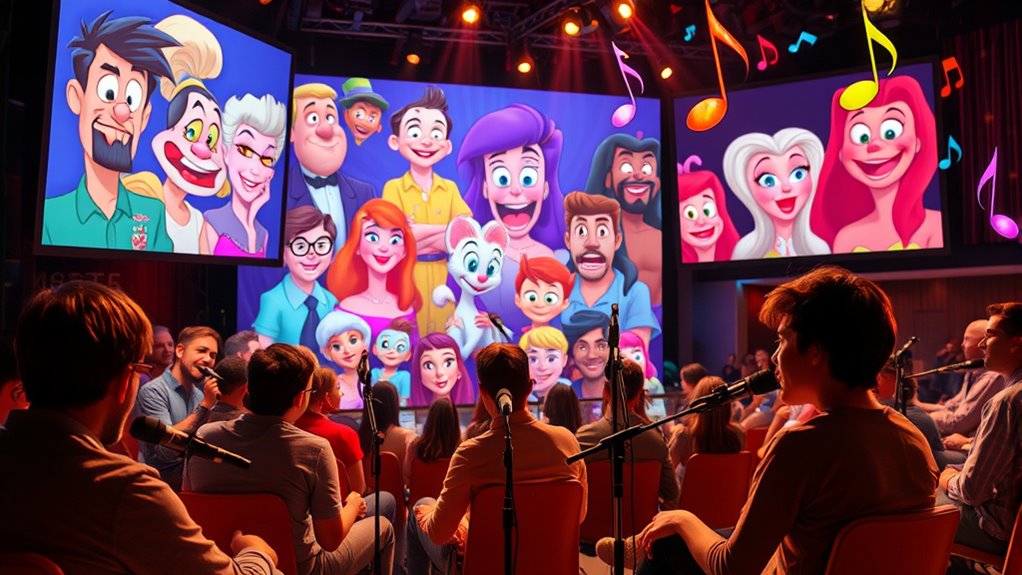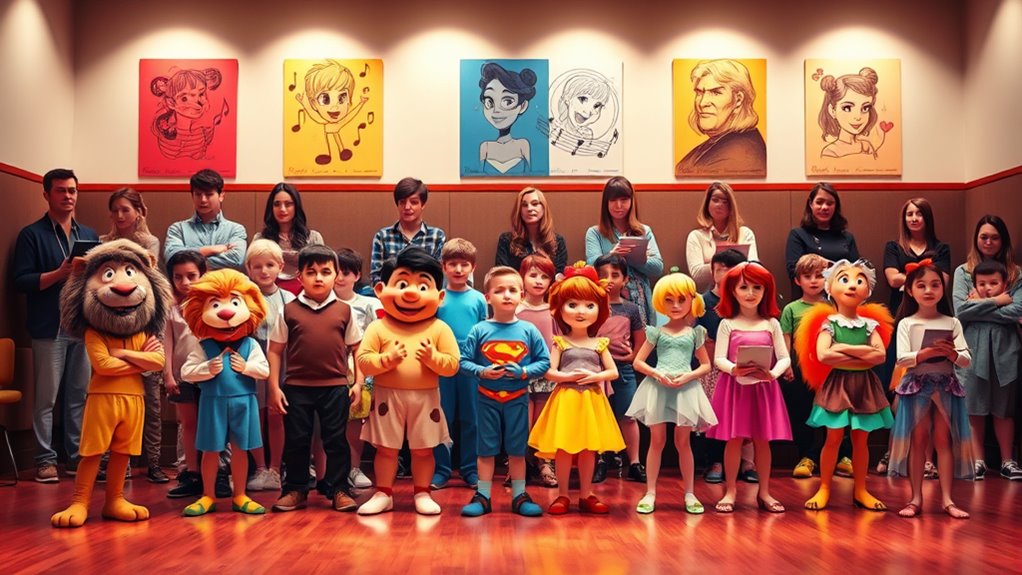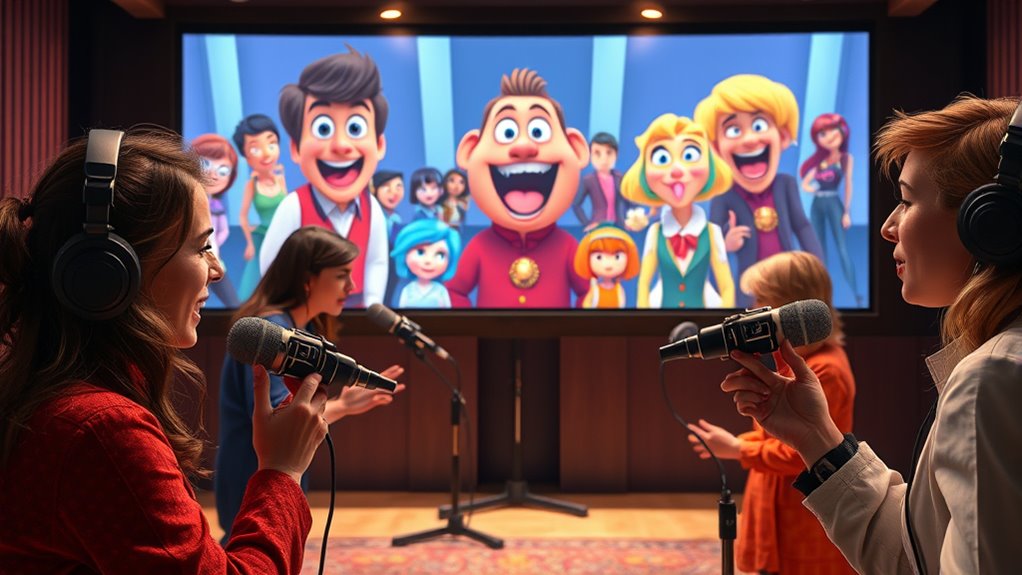In animated musicals, casting the perfect singing voices involves careful auditions to find voices that match characters while showcasing emotional depth and musical talent. Directors look for compatibility and chemistry among cast members, often working with voice coaches to refine tone and delivery. Multiple takes allow performers to experiment with dynamics, ensuring authenticity. By balancing original voices with character portrayals, producers create compelling performances that resonate emotionally—exploring these creative processes reveals how magic is brought to life on screen.
Key Takeaways
- Auditions assess vocal authenticity, emotional expression, and improvisation skills to match characters and musical style.
- Voice casting considers personality, tone, and musical compatibility to ensure natural vocal chemistry.
- Coaches refine tone modulation and emotional delivery through targeted training and multiple recording takes.
- Preparation routines like warm-ups and mental focus help performers connect emotionally and deliver authentic performances.
- Post-production adjustments and collaboration optimize vocal harmony, consistency, and overall storytelling impact.
The Importance of Vocal Casting in Animated Musicals

Vocal casting plays a crucial role in animated musicals because the right voice can bring characters to life and deepen the emotional impact of the story. When selecting voices, casting directors consider musical instrument selection to match each character’s personality and tone. This choice influences how their singing blends with the soundtrack and enhances the overall musical experience. Equally important is animation voice synchronization, ensuring voices align perfectly with characters’ lip movements and facial expressions. This seamless integration keeps the audience immersed and maintains the illusion of a lively, expressive performance. Additionally, understanding the role of brand reputation can guide casting choices that ensure quality and consistency in voice performances. By carefully choosing voices that complement both musicality and animation details, casting creates a cohesive, authentic feeling that resonates emotionally and elevates the musical’s storytelling power.
Audition Processes and Selection Criteria

Casting directors approach audition processes with a clear focus on finding voices that fit both the character and the musical style. You’ll be asked to demonstrate musical improvisation skills, showcasing your ability to adapt and bring spontaneity to your performance. They look for vocal stylization that matches the tone of the character, whether it’s playful, dramatic, or soulful. During auditions, you might perform a prepared song and then improvise sections to display your versatility. Directors also evaluate how well your voice can embody the character’s personality, emphasizing authenticity and emotional expression. Criteria include technical skill, musicality, and your ability to interpret the role through nuanced vocal choices. Ultimately, they seek voices that can authentically bring animated characters to life through expressive singing. Additionally, understanding floating on water can inspire a sense of fluidity and emotional depth, enhancing your vocal delivery and character portrayal.
The Role of Voice Coaches and Musical Directors

Voice coaches and musical directors play a vital role in shaping an actor’s singing performance for animated musicals. They work closely with performers to hone voice modulation, guaranteeing your tone and pitch match the character’s personality and emotional arc. These professionals help you unlock emotional expression, guiding you to convey feelings authentically through your voice. They identify subtle nuances in delivery, coaching you to add depth and nuance that resonate with audiences. By focusing on technical precision and emotional authenticity, they assure your singing feels genuine and compelling. Their expertise allows you to navigate complex melodies and dynamic ranges confidently. Additionally, understanding the subtle differences in vocal techniques is essential for mastering the nuances of animated musical performances. Ultimately, they help you find the perfect balance between technical skill and emotional storytelling, elevating your performance to bring animated characters vividly to life.
Chemistry and Compatibility Among Cast Members

When casting animated musicals, you need to take into account how well the voices blend together through vocal harmony synergy and character voice compatibility. Your cast’s collaborative chemistry development can make or break the authenticity of their performances. Focusing on these points ensures that the voices not only sound great individually but also work seamlessly as a unit. Additionally, fostering active listening and empathy among cast members can significantly enhance their ability to connect vocally and emotionally during performances.
Vocal Harmony Synergy
Vocal harmony synergy is essential for bringing animated musicals to life, as it reflects the natural chemistry and compatibility among cast members. When singers blend their voices, their musical phrasing must align seamlessly, creating smooth *passages* and emotional depth. This harmony depends on understanding each other’s vocal stylistics, ensuring that tone, pitch, and dynamics complement rather than clash. A well-coordinated cast can adapt their phrasing to match the song’s mood, enhancing storytelling. Achieving this *connection* requires careful rehearsing and an intuitive sense of timing, so that each voice supports the others. When cast members connect vocally, the result is a polished performance that feels both authentic and *engaging*, drawing audiences into the magic of the animated musical.
Character Voice Compatibility
Character voice compatibility is crucial because it guarantees that cast members’ personalities and tones mesh naturally, creating believable relationships on screen. When voices align with characters’ emotions, it enhances lip sync accuracy, making conversations feel seamless. Good compatibility also considers animation timing; if a voice’s rhythm matches the character’s movements, the scene feels more authentic. You want the voices to complement each other, so interactions don’t seem forced or disjointed. When cast members have compatible voices, their chemistry shines through, strengthening character dynamics. This harmony ensures that viewers connect emotionally and believe in the relationships portrayed. Ultimately, selecting voices that work well together enhances the overall storytelling, making animated musicals more immersive and engaging.
Collaborative Chemistry Development
Building genuine chemistry among cast members is essential for creating believable and engaging interactions in animated musicals. You’re encouraged to foster music collaboration through rehearsals and informal jam sessions, which help develop vocal chemistry. When cast members share a comfortable rapport, their voices blend naturally, enhancing the authenticity of duets and group numbers. This chemistry is not just about technical harmony but also about emotional connection, making performances more compelling. By actively encouraging open communication and collaborative practice, you enable cast members to understand each other’s nuances. The result is a seamless integration of voices that feels spontaneous and lively, enthralling audiences and elevating the overall quality of the musical. Strong vocal chemistry ultimately brings characters to life and resonates deeply with viewers.
Recording Sessions and Vocal Refinement Techniques

During recording sessions, you’ll start with vocal warm-up routines to guarantee your voice is prepared. You’ll often record multiple takes to capture the best performance, then refine pitch and tone adjustments in post-production. This process helps achieve the polished, expressive sound essential for animated musical characters. Incorporating professional audio equipment can further enhance the clarity and quality of the final recording.
Vocal Warm-Up Routines
Vocal warm-up routines are essential for singers to prepare their voices for recording sessions and guarantee peak performance. Proper warm-ups help you achieve clarity in dialogue delivery and enhance emotional expression. To maximize effectiveness, follow these steps:
- Start with gentle breathing exercises to relax your vocal cords and improve breath control.
- Perform scales and lip trills to warm up pitch accuracy and flexibility.
- Practice specific phrases from the musical, focusing on emotional nuance and dialogue delivery to ensure your voice conveys the character’s feelings authentically.
These routines not only prepare your voice physically but also mentally, helping you connect emotionally with the material. A well-structured warm-up ensures your voice is versatile, expressive, and ready for the demands of animated musical recording.
Multiple Takes Strategy
Implementing multiple takes during recording sessions allows you to capture a range of performances, giving you options to choose from and refine later. This approach lets you explore different voice modulation techniques, ensuring the singer conveys the appropriate emotional expression for each scene. By recording several versions, you can identify subtle nuances in tone and delivery that enhance the character’s personality. It also provides flexibility to blend elements from different takes, resulting in a more polished and impactful performance. During this process, encourage the singer to experiment with dynamics and phrasing, which can lead to more authentic emotional expression. Ultimately, the multiple takes strategy helps create a vibrant, emotionally resonant vocal track that elevates the overall impact of the animated musical.
Pitch and Tone Adjustment
Adjusting pitch and tone is essential for refining a singer’s performance and ensuring it aligns with the character’s emotional intent. During recording sessions, you focus on precise vocal pitch to match the desired melody and mood. Tone modulation helps shape the singer’s vocal color, making it expressive and fitting for the scene. Techniques like subtle pitch correction and dynamic tone adjustments allow you to enhance clarity and emotional impact. To achieve this, consider these key steps:
- Fine-tune vocal pitch with software tools for perfect melodic accuracy.
- Use tone modulation techniques to emphasize or soften certain phrases.
- Revisit recordings to ensure consistent vocal pitch and tone across takes.
This process guarantees a polished, emotionally resonant vocal performance for animated musicals.
Balancing Original Voices With Character Portrayal

Balancing the original voices with character portrayal is a delicate task that requires careful consideration. You need to blend musical improvisation and voice modulation techniques to guarantee the voice fits the character’s personality while maintaining authenticity. Sometimes, an actor’s natural tone may need slight adjustments to match the character’s emotional arc, without losing their unique vocal qualities. It’s about finding harmony between the actor’s natural voice and the demands of the role, so the audience connects with both the character and the performance. This balance helps create a believable, engaging experience. When done well, it elevates the musical and makes the character’s journey more compelling, all while respecting the actor’s original voice and artistic expression. Utilizing voice modulation techniques can further enhance this balance and ensure the performance resonates authentically with viewers.
Frequently Asked Questions
How Do Animated Musicals Choose Voices That Match Animated Characters’ Personalities?
When selecting voices for animated musicals, you consider the character’s personality and development. You look for a vocal tone that matches their traits—bright for cheerful characters, deep for serious ones. You also guarantee the voice actor can bring authentic emotion, enhancing character development. By aligning vocal tone with personality, you create a believable, engaging character that resonates with audiences and elevates the storytelling.
What Impact Does Voice Casting Have on the Overall Success of an Animated Musical?
Voice casting plays a pivotal role in an animated musical’s success by enhancing voice characterization and engaging audiences. When you choose diverse voices, it adds authenticity and broadens appeal, making characters more relatable. Effective casting influences emotional connection, helps tell the story more convincingly, and can boost popularity. So, your thoughtful casting decisions directly impact the musical’s reception, ensuring it resonates with viewers and stands out in a competitive landscape.
How Do Voice Actors Prepare Differently for Animated Roles Compared to Live-Action?
Ever wondered how voice actors prep differently for animated roles? You focus more on voice audition techniques and character voice development, rather than physical acting. You might record multiple takes, experiment with tone, pitch, and emotion, and analyze the character’s personality deeply. Unlike live-action, your voice must convey everything, so you hone your vocal skills to bring the animated character vividly to life without visual cues.
Are There Specific Vocal Qualities That Make a Voice More Suitable for Animation?
You’ll find that certain vocal qualities, like strong vocal projection and an expressive tone, make a voice more suitable for animation. These qualities help convey emotions clearly and keep listeners engaged, even in exaggerated or fantastical scenes. Your voice needs to cut through the mix and maintain energy, so casting directors look for actors who naturally project and can deliver an expressive tone that brings animated characters to life vividly.
How Is Audience Reception Influenced by Casting Choices in Animated Musical Films?
You might think casting choices don’t impact audience reception, but they considerably influence engagement and emotional resonance. When the voices match characters perfectly, viewers connect deeply, feeling more involved. Thoughtful casting elevates the story, making it memorable. Even if some doubt casting’s importance, it’s clear that well-chosen voices enhance overall experience, fostering a stronger bond between the audience and the animated world.
Conclusion
Think of casting in animated musicals as planting seeds in a vibrant garden. When each voice blooms with authenticity and harmony, the entire landscape comes alive, enchanting your senses. Your chosen voices are the roots that anchor the story, growing into a lush tapestry of emotion and melody. With the right nurturing, they flourish, transforming each scene into a breathtaking tableau. Ultimately, your cast’s perfect harmony creates a timeless masterpiece that touches hearts forever.









